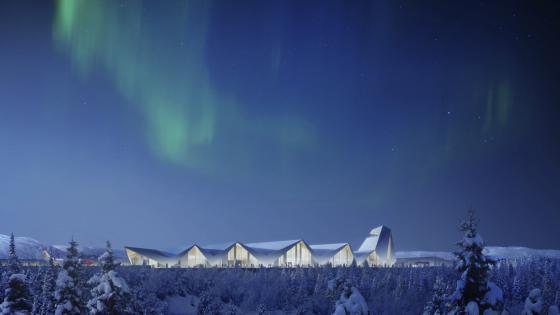
A rendering of the new Mo i Rana Airport with the Northern Lights
Norwegian airports operator Avinor Group is to build a new airport at Mo i Rana, south of the Arctic Circle. Project director Bjarte Nesse told Tara Craig about the ambitious plans.
Mo i Rana may have a population just shy of 20,000 people, but this small Norwegian town punches well above its weight in terms of industry. A market town from the 18th Century onwards, it became renowned for both mining and boatbuilding, followed by iron and steel production, which dominated the local economy until the 1990s. Today, Mo i Rana relies on the service sector, although new, environmentally friendly industries are emerging. Situated at the innermost point of the Ranfjord, Mo i Rana is just 80km south of the Arctic Circle. Its climate is classified as subarctic, with proximity to the coast bringing colder winters than are found further inland. Heavy snow is common throughout the winter, with blizzards lasting hours.
The town is served by a regional airport situated 10km north of Mo i Rana, in Røssvoll. For more than two decades, there has been talk of building a new, bigger airport, capable of handling larger aircraft. Avinor Group confirmed the project in 2014 and, a year later, appointed Nordic – Office of Architecture and Haptic to design the new facility. In May 2022, Norway's Ministry of Transport and Communications awarded a licence to Avinor for its construction and operation.
The new airport will feature a 2,400m runway, an apron with six aircraft stands, a 6,000m2 terminal and a 4,000m2 service building. It will have space for operational and maintenance equipment, in addition to a 580-space passenger parking facility.
Airports International put a series of questions to project director Bjarte Nesse

Bjarte Nesse is project director on the Mo i Rana build
At what stage is the project?
The airport is expected to open in 2025 and is now at the preparatory stage. In August 2022, it was announced that Norwegian civil engineering firm AF Gruppen would build the new airport in Mo i Rana. It was appointed general contractor for the construction, and the contract between Avinor and AF Gruppen was signed in September. The construction will take place on a collaborative basis, meaning that Avinor and AF Gruppen will work together to find the best waysto carry out the project.
Immediately after the signing of the contract, the optimisation phase began. In this phase, Avinor and AF Gruppen will research the best solutions for the project and agree on a final target price. The construction contract for this phase will help ensure that the overall project is carried out within Avinor's cost framework. Phase two will also fall within this framework.
In September, the construction work started on the site at Fagerlia, and on September 26 the first charge of dynamite went off. Over the next year, demolition experts Nitrex will set off 180,000kg of dynamite, to prepare fora new road to the new airport.
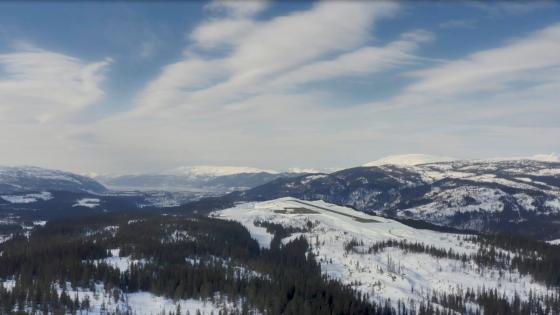
The new airport will be built at Fagerlia, a few kilometres to the south of the existing facility
We do not have a single IT or airport management system, but several interactive systems that need to be seen in context
How much will the airport cost and where will the funding come from?
The construction of the new airport hasa cost framework of €314m, whichwas agreed in 2020. In 2021, it was confirmed that the Norwegian state will contribute €257m to the project. The project is a joint venture between the state, Rana (Mo i Rana is administrative centre of the municipality) and local businesses. The municipality will provide €42.9m of funding, while local businesses and private donors will contribute €14.3m.
What new technology will be installed?
Avinor aims to plan, build and put into operation a new future-oriented and environmentally adapted airport in accordance with current and future environmental requirements and standards. Our goal is for the Rana community to be proud of its new airport.
At the new airport, arrangements will be made for buses and taxis and charging stations for electric cars will be installed. Remote air traffic control towers are planned and there will be satellite-based navigation solutions.
What IT systems will the new airport feature?
We expect to have many different IT systems in use at Mo i Rana, as is the case with all Avinor airports. Among the key systems are: common use passenger processing systems (CUPPS) equipment at check-in and gate counters, with Amadeus ACUS (airport common use service) and common use self-service (CUSS) check-in kiosks. These are also delivered by Amadeus, subcontracted to Materna, although the framework agreement will be up for renewal in 2024.
We also have an agreement with SITA for the provision of a self-service bag drop. IBM will provide the AODB (airport operational database) and we will be looking to set up a new RMS (resource management system) agreement in 2023.
In a nutshell, we do not have a single IT or airport management system, but several interactive systems that need to be seen in context.

A 580-space passenger car park will be among the amenities offered by the new facility
Our goal is for the Rana community to be proud of its new airport
How will the new airport improve on its predecessor?
Avinor has been commissioned by the Ministry of Transport to build the new airport in Mo i Rana. The airport will provide a good, enhanced transport service for the larger community in Helgeland and is expected to boost business in the region. During the development period, Avinor will work with Rana municipality, Polarsirkelen Lufthavnutvikling (PLU; Polarsirkelen airport development), and the rest of the local community to develop an efficient, modern and forward-looking facility.
The existing airport is surrounded by high mountains, which creates challenges for incoming and outgoing flights. It is therefore unsuitable for longer runways and larger aircraft. The impetus for building a new airport is a desire to strengthen the transport offering and business life in Helgeland through a longer runway, which will make it possible to offer direct routes to Oslo, as well as internationally.
The current airport has a capacity of around 120,000 travellers per year. However, the new Mo i Rana airport will be able to handle 196,000 passengers in its opening year, rising to 220,000 over the course of 15 years. Our passengers are a combination of business and leisure travellers, as well as health travellers, who travel to and from hospitals. Small planes carrying up to 39 seats have a limited capacity. The new airport will offer an expansion, both in terms of price and capacity.
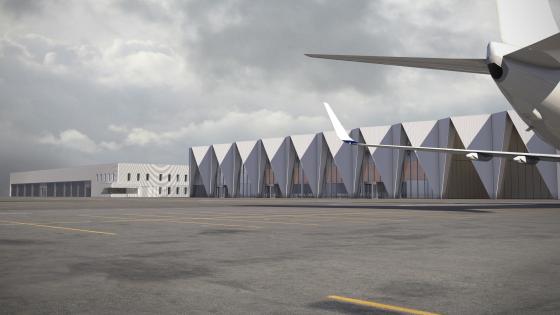
The increased capacity is expected to boost both leisure and business travel through Mo I Rana
It is unusual to build an entirely new airport in harsh Arctic conditions
What opportunities will the airport create?
The new airport will provide opportunities for major development of the Helgeland region. At present, for instance, the capacity of the airport makes it practically impossible to host larger events, such as conferences, in Mo i Rana town.
Business development will also generate a need for travel. Norwegian construction company Hent has been commissioned to build Freyr Battery’s 120,000m2 Giga Arctic battery factory at Mo I Rana. With a more international labour market and employees from all over the world at the battery factory, and all the activity around developments in the industry, there will be an increased need for accessible seats.
In addition, tourist travel will become easier. Direct routes to, for example, Oslo will give leisure travellers a broader offer of available seats at affordable prices. Today, most leisure trips are taken to and from the nearest major airports, such as Bodø or Trondheim.
The new airport will, within a 90-minute drive, be able to support a population of more than 160,000 people in Norway and Sweden, with new routes and connections both in Norway and across Europe.

The new airport has been designed to echo the nearby mountains and glacier
What is distinctive about the design of the new terminal?
What will set the new terminal building apart is that the architectural design has been adapted to the surrounding landscape. Its setting has been interpreted in a facade inspired both by the neighbouring mountains and the Svartisen glacier, which is Norway’s second largest. It is also unusual to build an entirely new airport in Arctic conditions. This requires a series of adaptations during construction phase and later operational use.
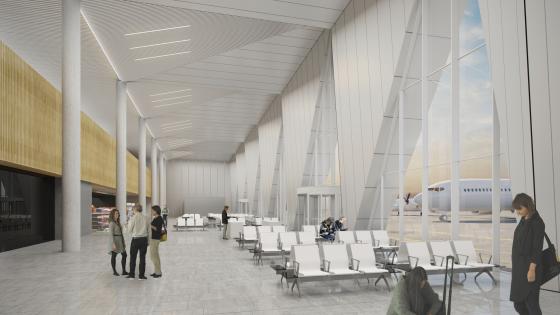
Large windows are intended to make the most of the short daylight hours during winter
Will the new airport be able to handle larger aircraft, capable of longer flights?
Yes. The new airport will have a runway of 2,200-2,400m and is designed to handle larger aircraft such as category C (737) and possibly category E, which will make it possible to offer direct routes to Oslo as well as international routes. This will make all of Europe accessible by direct flights from Mo i Rana.
Do you expect to attract new airlines to the region?
Yes, at Avinor we always work hard to attract airlines, which, in turn, set up flight routes. A longer runway will make it possible to offer direct routes to Oslo and to southern Europe and other international destinations, which will open new possibilities regarding airlines and routes. Furthermore, the airport will be equipped for winter operations and will operate all year round.
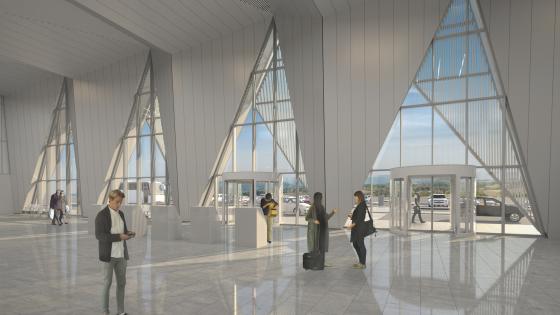
A new, longer runway will enable the airport to provide direct flights all over Europe
Avinor is working hard to reduce the environmental footprint when building and operating airports
How will you ensure the new terminal (and its build) is environmentally friendly?
Avinor is working hard to reduce the environmental footprint when building and operating airports. To assure and document sustainability and make the new airport project as environmentally friendly as possible, we plan to certify the project in accordance with BREEAM assessment method (for the sustainable built environment).
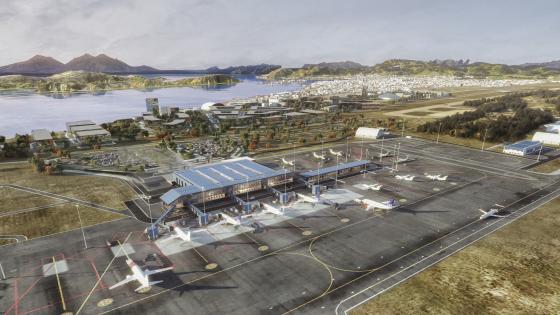
December 2022 saw Avinor’s board of directors approve the construction of a new airport at Bodø, just north of the Arctic Circle
Need to know more: Bodø Airport
The new facility at Mo i Rana is not the only new Avinor-run airport on the horizon. In December 2022, the group’s board of directors approved the construction of a new Bodø Airport, which is scheduled for completion in 2029.
The project cost is €683m at 2022 prices, not including the purchase of land and excluding financing costs. Avinor will provide €246m, with the remaining costs covered by the government and local funds.
Avinor CEO Abraham Foss said:“We are pleased to make this decision following a lengthy process that has involved the Norwegian armed forces [which shares the airport facilities] and the municipality of Bodø. We are going to build a new airport, and the urban development project will have a major impact on the entire region.”
The project has not been without its challenges, not least because of Avinor’s post-pandemic financial status.
“It goes without saying that this has been a difficult issue for Avinor,” said Foss. “On the one hand, we are keen to develop a new airport and we have always been clear about this. The municipality of Bodø is also keen to see a new airport built, while also being given the opportunity to build a new neighbourhood. Furthermore, the project has enjoyed broad political support in the Storting [the Norwegian parliament].
“At the same time, this is a very costly project that will have an impact on our finances for many years to come. This is a big project for Avinor, the municipality of Bodø and the Norwegian armed forces. It is only natural that the path to a final decision has been rather long and winding, even if all parties involved had a clear desire to get it over the finishing line.”
The first contract win will be announced at the beginning of January. This will be for the construction of the runway, taxiways, aircraft stands and other external infrastructure.
The new Bodø Airport will be located around 900m to the south of the present airport. The latter will remain operational until the day before the new airport opens for operations.
